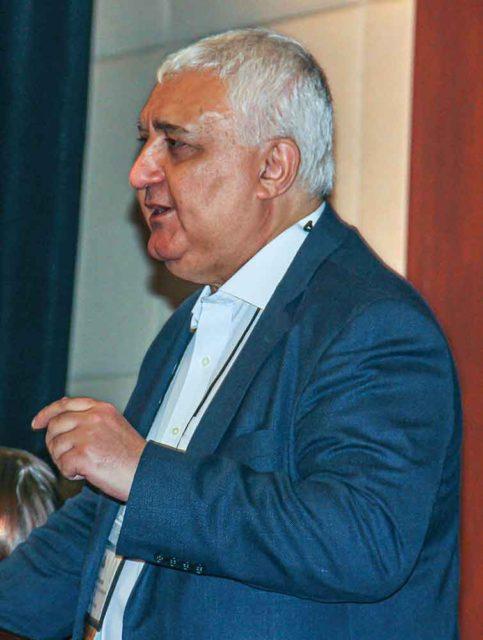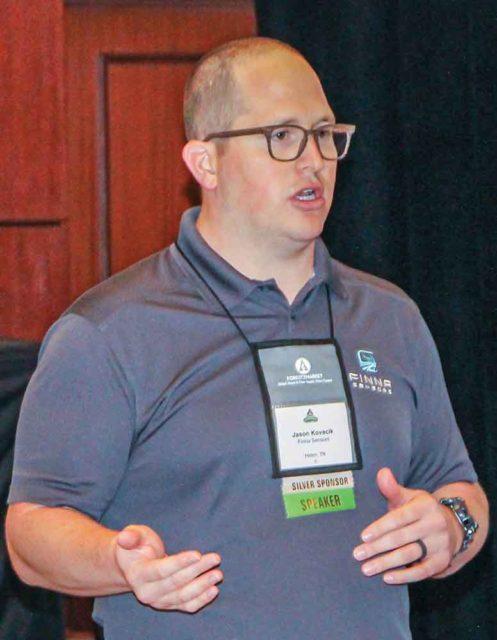Equipment Companies Reveal Latest Developments
REGISTRATION
EXHIBITOR LIST
CONTACT US
Wood Bioenergy editors Rich Donnell, Jessica Johnson, Dan Shell and David Abbott contributed to this story
EDITOR’S NOTE: This is the second part of three parts in the coverage of the Wood Bioenergy Conference & Expo held March 29-30, 2022 at the Omni Hotel at CNN Center and hosted by Wood Bioenergy magazine. Part one in the June issue focused on the keynote talks from producer and consultant personnel. Part two highlights several presentations delivered by representatives of equipment and technologies companies. Look for part three in the October issue.
 ATLANTA, Georgia – Tyler Player, president of Player Design Inc. (PDI), addressed the company’s development and technology involvement in collaboration with Active Energy Group (AEG) on the CoalSwitch steam-beneficiated pellet, now in pilot scale production in Ashland, Maine, and undergoing testing at sites in North America and Japan.
ATLANTA, Georgia – Tyler Player, president of Player Design Inc. (PDI), addressed the company’s development and technology involvement in collaboration with Active Energy Group (AEG) on the CoalSwitch steam-beneficiated pellet, now in pilot scale production in Ashland, Maine, and undergoing testing at sites in North America and Japan.
Player pointed to several advantages of the product over white pellets, including energy production, cost efficiency, co-firing with coal, and minimal expenditure to convert existing fossil fuel operations. He addressed impressive performance data of CoalSwitch, noting it has “proven to blend with coal at the conveyor or supplant coal entirely with retrofitting for existing coal fired power stations” and with carbon values comparable to coal.
As the venture expands marketing and sales efforts domestically and internationally, the product has achieved Chain of Custody and Controlled Wood Certification compliance with the Forest Stewardship Council. Player said they are focusing not only on power utility partners but other industry coal users.
A 70,000 ton full-scale manufacturing plant is plan – ned to be in operation by the first quarter of 2023, while identifying sites for other facilities and increasing production in 2023 and beyond.
 Dane Floyd, principal at Biomass Engineering & Equipment, in his talk entitled, “The Time Bomb: Dust Safety in Wood Plants,” passionately touched on the recent deaths of three workers at a wood processing plant in Quebec.
Dane Floyd, principal at Biomass Engineering & Equipment, in his talk entitled, “The Time Bomb: Dust Safety in Wood Plants,” passionately touched on the recent deaths of three workers at a wood processing plant in Quebec.
Floyd reviewed NFPA (National Fire Protection Assn.) codes and standards, and OSHA standards and proceeded to show photos of various plants which were obviously not in accordance.
Floyd addressed how to control dust, as with enclosed “dust tight” bins and conveyors; negative pressure on leaky machines; spark detection and deluge; explosion panels, flameless vents, anti-blowback devices; isolation of conveyors.
He specifically pointed to his company’s SMART conveyor material handling product, referring to reduced power requirements, enclosed dust tightness construction, and other characteristic in compliance with NFPA standards for dust hazard safety.
 Bijan Shams, president of Cogent Industrial Technologies, addressed the complexity of delivering capital projects, noting that 70% of them fail, while the ones that succeed combine a stellar project execution team and project management team.
Bijan Shams, president of Cogent Industrial Technologies, addressed the complexity of delivering capital projects, noting that 70% of them fail, while the ones that succeed combine a stellar project execution team and project management team.
He addressed the steps of project execution, always with an eye on the outcome of delivering a safe, reliable and data-driven plant to drive the highest efficiency from assets, people and processes.
He also broke down project management into multiple phases and responsibilities, and kidded, “What could possibly go wrong?” He focused on the big picture phases of project management: initiation, planning, executing, monitoring/controlling the execution and closing. He cited the project filer server and project issue tracker as necessary tools throughout the project.
Circling back, Shams said the main causes of capital project failures are poor project execution and poor project management. Key reasons for execution failure include the wrong technology selection (which can cause headaches for years), neglecting safety and hiring the wrong team.
Key reasons for project management failure include poor contracts, lack of planning, poor monitoring and controls, and poor issue management and coordination, all of this leading to delays and overbudgeting.
 Jason Kovacik, sales manager with Finna Sensors, spoke on production enhancements and profitability by using IoT data-driven moisture control measurement sensors. He reviewed why IoT sensors are trending, including real-time process data, visibility of process trends and conditions, and more focused analysis. Compared to nonenabled sensors, IoT sensors enable cloud-based updates, remote diagnostics, and monitoring of sensor health and performance.
Jason Kovacik, sales manager with Finna Sensors, spoke on production enhancements and profitability by using IoT data-driven moisture control measurement sensors. He reviewed why IoT sensors are trending, including real-time process data, visibility of process trends and conditions, and more focused analysis. Compared to nonenabled sensors, IoT sensors enable cloud-based updates, remote diagnostics, and monitoring of sensor health and performance.
Kovacik spoke on the criteria for integrating IoTenabled sensors into your process, including partnering with the right organization and having a strategy for adoption. More technology-specific, he focused on Finna’s OMNIR non-contact, non-destructive, real-time moisture control measurement, which features white light, near-infrared energy filtering and resonance frequency of water molecules, and with advantages built into the associated and minimized system hardware.
OMNIR can be implemented in numerous areas of a production facility, including pre- and post-dryer.
 Jaymie Deemer, president of Nestec, Inc., gave an in-depth look at dryer WESP and RTO systems, including the complexities of wood dryer emissions sometimes associated with the dryer technologies and with the particulate materials themselves. Some of these issues, as well as others, can contribute to common ESP and RTO issues and problems.
Jaymie Deemer, president of Nestec, Inc., gave an in-depth look at dryer WESP and RTO systems, including the complexities of wood dryer emissions sometimes associated with the dryer technologies and with the particulate materials themselves. Some of these issues, as well as others, can contribute to common ESP and RTO issues and problems.
He said, “Wet ESP performance and design of critical components are key to reliable operation,” and pointed to numerous such features in both WESP and RTO design, including, in the former, isolable electric fields, extended flushing, simple electrode alignment, irrigation, plug resistant spray nozzles, power supply, continuous loop blowdown, high temperature water flush, caustic grade; and in the latter, proper media, draft arrangements, multiple burners, and proper construction materials such as mastic coatings to protect the shell from condensation, and which materials to avoid such as low grade stainless steel.
 Rodney Schwartz, vice president Sales & Business Development, Dürr Systems, spoke on the development and testing of new WESP design enhancements including an optimized electrode and tube design. After reviewing various factors that influence WESP performance, and issues and concerns with current designs, he said Dürr approached producers and operators to get their input on current designs. The feedback included: tubes and electrodes get dirty and are difficult to clean, potentially impacting collection performance; capital cost is too high; installation time is too long; foaming problems; mist carryover into RTOs; performance drop when flushed.
Rodney Schwartz, vice president Sales & Business Development, Dürr Systems, spoke on the development and testing of new WESP design enhancements including an optimized electrode and tube design. After reviewing various factors that influence WESP performance, and issues and concerns with current designs, he said Dürr approached producers and operators to get their input on current designs. The feedback included: tubes and electrodes get dirty and are difficult to clean, potentially impacting collection performance; capital cost is too high; installation time is too long; foaming problems; mist carryover into RTOs; performance drop when flushed.
Dürr promptly set goals for a new WESP based on the feedback, including modular shipping design, better fabrication, flexible sizing, new patentable ideas, online cleaning, offline flushing.
Dürr developed a 1/6th to-scale test model and performed testing over 16 weeks with 27 separate flow tests and 55 different particulate removal tests. Testing included various configurations of electrodes, including bottom mounted discharge electrodes that proved highly effective, and including the use of a High Area Trap (HAT) that showed numerous benefits.
They then built a to-scale 25,000 acfm pilot WESP that was installed at an OSB customer site in the Southern U.S. and was tested for 10 months downstream of rotary flake dryers. The new designs scored high compared to older designs on filterable particulate removal, organic condensable particulate removal, enhanced spray system cleaning and proved multiple other benefits.
 The key features of the new product include maximum removal efficiencies, reliable operation, low operating costs, and significantly reduced maintenance. Jeff Nichols, managing partner at Industrial Fire Prevention, speaking on behalf of Fagus Gre- Con, noted wood and wood products still account for a significant share of dust-related industrial fires and explosions.
The key features of the new product include maximum removal efficiencies, reliable operation, low operating costs, and significantly reduced maintenance. Jeff Nichols, managing partner at Industrial Fire Prevention, speaking on behalf of Fagus Gre- Con, noted wood and wood products still account for a significant share of dust-related industrial fires and explosions.
He addressed Gre- Con’s range of spark extinguishing, fire protection and spark detection products, including the new DLD 1/9 spark detector.
He also spoke on the company’s extinguishment systems with atomized water droplet technology for larger spacing, better cooling and less usage.
 Bernardo Sanson, sales engineer with CV Technology, addressed fire and explosion protection for biomass processes. He reviewed combustible dust basics, including dust ignition, and the multiple hazardous areas within the production facility.
Bernardo Sanson, sales engineer with CV Technology, addressed fire and explosion protection for biomass processes. He reviewed combustible dust basics, including dust ignition, and the multiple hazardous areas within the production facility.
He clarified the meaning of prevention and mitigation strategies and said a full solution often combines them in the name of optimal safety. Specifically for mitigation, he talked about explosion venting and flameless venting, the latter referred to as a passive mitigation technology using stainless steel mesh to extinguish the flame.
For fire prevention he spoke on spark detection and advances in the technology such as infrared detection— allowing detection of sparks at lower temperatures—intelligent detectors and remote monitoring. He addressed water mist quick suppression ideally suited for areas with hot bearings, motors, sparking equipment and heat generation.
“Biomass processes can have multiple areas with high risk of ignition sources,” Sanson said. “Understanding the risk scenario at each part of the process is crucial to managing these risks.” He added that a combination of explosion mitigation and fire prevention solutions allow for minimal loss in production, minimal downtime and enhanced safety performance.
 Andrew Johnson, vice president at TSI, spoke on the company’s rich history and development with torrefaction technology, and spoke on customized torrefaction through temperature and process controls.
Andrew Johnson, vice president at TSI, spoke on the company’s rich history and development with torrefaction technology, and spoke on customized torrefaction through temperature and process controls.
He said TSI built its pilot torrefactor in 2012, installed a scaled up torrefactor in 2013, developed a system to torrefy sugar cane leaves and bagasse in 2015 for a plant in Louisiana, installed a torrefactor in Thailand to torrefy pre-made pellets in 2019, installed one in Vietnam in 2021 and this year started construction on a 120K tpy system for the Japanese market.
Johnson said their technology has shown a positive experience in power station co-firing and in outright replacement of coal in power plants.
He reviewed the technology flow through the TSI system and concluded that “the technology is starting to go prime time,” pointing to applications not only as solid fuel for power production but in metallurgical coal applications, chemical compound recovery, concrete production, polymer extender, pre-treatment for gasification and bio-based hydrogen.
